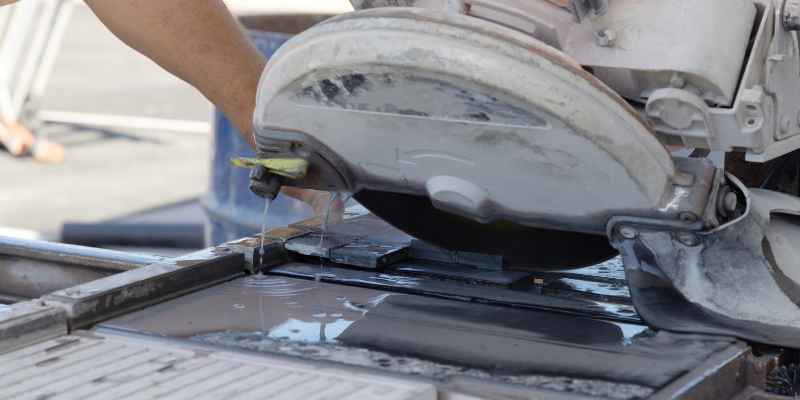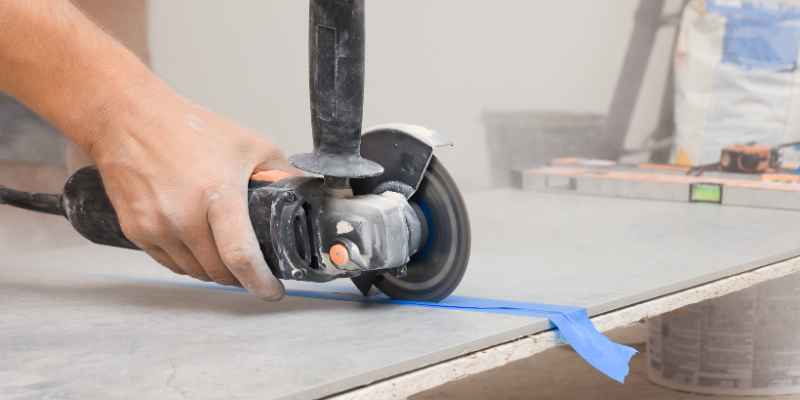A wet saw tile blade is specifically designed for cutting tiles using water as a lubricant to reduce heat and dust. It is important to choose the right blade based on the type of tile you are cutting and the wet saw machine you are using.
Using a wet saw tile blade can significantly improve the precision and efficiency of your tile cutting projects. Proper maintenance and care of the blade will also extend its lifespan and ensure consistent performance. We will discuss the features to consider when selecting a wet saw tile blade, how to use it effectively, and some tips for maintaining and replacing the blade.
So let’s dive in and explore everything you need to know about wet saw tile blades.
Choosing The Right Wet Saw Tile Blade
When it comes to tiling projects, choosing the right wet saw tile blade is crucial for achieving precise and clean cuts. Selecting the appropriate blade ensures efficiency and accuracy in your tile cutting tasks.
Size Of The Blade
The size of the blade refers to its diameter, which typically ranges from 4 inches to 10 inches. The larger the blade size, the deeper the cuts it can make on the tile.
Type Of Material
The type of material the blade is made from is an important consideration. Diamond blades are the most common choice for wet saws as they offer durability and precision when cutting through various tile materials.
Diameter And Arbor Size
The diameter and arbor size of the blade are essential specifications to match with your wet saw. Ensure the blade’s diameter fits the saw’s capacity and that the arbor size is compatible for proper installation.

Preparing The Tile And Wet Saw
Measurements And Markings
Start by measuring and marking the tiles you need to cut, ensuring accuracy.
Wetting The Blade
Before cutting, make sure to wet the blade to reduce friction and prevent overheating.
Proper Water Flow
Ensure adequate water flow in the wet saw to keep the blade cool and effective.
Proper Technique For Cutting Tiles
Cutting tiles can be a daunting task if not done with proper technique. Whether you are a DIY enthusiast or a professional tile installer, applying the correct technique ensures clean and precise cuts every time. In this article, we will explore the key steps for cutting tiles using a wet saw tile blade. By following these guidelines, you can achieve professional-looking results and minimize the risk of chipping or damaging the tiles.
Positioning And Alignment
Before you begin cutting the tiles, it is crucial to ensure proper positioning and alignment. Start by measuring and marking the desired cutting line on the tile using a pencil or marker. Next, place the tile on the wet saw with the marked line aligned with the blade. It is essential to align the tile carefully to maintain accuracy throughout the cutting process.
Applying Appropriate Pressure
Once the tile is correctly positioned, apply appropriate pressure during the cutting process. Pressing too hard can cause the tile to crack or break, while not applying enough pressure can result in a jagged or incomplete cut. Aim for a firm and steady pressure on the tile as you guide it through the wet saw blade. It is recommended to start with a lighter pressure and gradually increase it as you gain confidence in controlling the saw.
Slow And Steady Cutting Motion
The speed at which you cut the tile is crucial for achieving clean and accurate results. A slow and steady cutting motion is highly recommended during tile cutting. Rushing or forcing the tile through the saw blade can lead to uneven cuts, chipping, or even accidents. Take your time and move the tile smoothly along the marked cutting line, allowing the blade to do the work. Remember, patience and controlled movement are key to successful tile cutting.
Maintaining The Wet Saw Blade
Maintaining the wet saw blade is crucial for achieving consistent and high-quality tile cuts. Proper maintenance not only extends the lifespan of the blade but also ensures optimal performance. By following a few simple steps, you can keep your wet saw tile blade in top condition, allowing it to cut through tiles smoothly and efficiently.
Cleaning The Blade
Regularly cleaning the wet saw blade is essential to prevent the buildup of debris, grime, and resin that can affect its cutting ability. To clean the blade:
- Remove the blade from the saw.
- Immerse it in a solution of water and mild detergent to dissolve built-up residues.
- Use a wire brush to gently scrub the blade to remove any stubborn residue.
- Rinse the blade thoroughly with clean water and allow it to dry completely before reinstallation.
Inspecting For Wear
Regular inspection of the blade is essential to identify signs of wear and tear. When inspecting the blade:
- Look for chipped or missing diamond segments.
- Check for warping or bending of the blade.
- Inspect the arbor hole for any signs of damage or excessive wear.
- Ensure the blade is free from cracks or other visible defects.
Replacing The Blade
Replacing the wet saw tile blade is necessary when it shows significant wear or damage. Signs that indicate it’s time to replace the blade include:
- Reduced cutting efficiency or precision.
- Increased chipping or splintering of tiles.
- Excessive noise or vibration during cutting.
- Visible signs of wear or damage during inspection.
Common Mistakes To Avoid
When using a wet saw tile blade, it’s vital to avoid common mistakes that can lead to inefficiency, damage to the blade, or compromised safety. By being aware of these potential pitfalls, you can ensure smooth and effective cutting while extending the lifespan of your blade. Let’s explore the most common mistakes to avoid when using a wet saw tile blade.
Using The Wrong Blade Type
Using the appropriate blade type for the material being cut is critical to achieving optimal results. If the wrong blade is selected, it can lead to chipping, uneven cuts, or premature blade wear. Always match the blade type to the specific material, such as porcelain, ceramic, or natural stone, to maximize cutting performance and minimize potential damage.
Not Wetting The Blade Properly
Proper hydration of the blade is essential for reducing friction and preventing overheating, which can result in blade warping or premature dulling. Ensure the blade is adequately soaked before use, and maintain a steady flow of water during cutting to keep the blade cool and lubricated. Neglecting this vital step can lead to subpar cuts and blade degradation.
Applying Excessive Pressure
Avoid exerting excessive force when guiding the material through the blade. Applying undue pressure can lead to overheating, vibration, or even blade deflection, resulting in inaccurate cuts or potential safety hazards. Instead, let the blade do the work, applying gentle and consistent pressure to facilitate a smooth and precise cutting process.
Safety Precautions
Ensure safety by wearing appropriate gear and using caution when operating a wet saw tile blade. Always follow manufacturer instructions for safe handling and operation to prevent accidents. Prioritize safety measures to avoid potential risks and injuries while working with wet saw tile blades.
Wearing Protective Gear
When operating a wet saw tile blade, it is crucial to prioritize your safety and wear the necessary protective gear. This helps to minimize the risk of accidents and injuries. Always wear safety goggles to protect your eyes from flying debris and splashes of water. Additionally, use ear protection such as earmuffs or earplugs to safeguard your hearing from the loud noise produced by the wet saw. Donning a dust mask or respirator is also important to prevent the inhalation of harmful dust particles that may be generated during the cutting process.
Proper Ventilation
Ensuring proper ventilation in the work area is another essential safety precaution when using a wet saw tile blade. Operating the wet saw in a well-ventilated space helps to remove fumes and dust particles, making the environment safer for both the user and others nearby. Ideally, work in an area with open windows or use fans to improve air circulation. Adequate ventilation not only reduces the risk of respiratory problems but also prevents the accumulation of dust, which can hinder the effectiveness and efficiency of the wet saw blade.
Safety Switch And Power Cord
The presence of a safety switch and a well-maintained power cord are crucial aspects to consider when using a wet saw tile blade. The safety switch allows you to easily turn off the machine in the event of an emergency or if you need to temporarily halt the cutting process. It is recommended to familiarize yourself with the location of the safety switch and ensure it is easily accessible. Moreover, regularly inspect the power cord for any damage or fraying. A damaged power cord can pose a significant safety hazard and should be replaced immediately.
Remember, the safety precautions mentioned above are vital to ensure a safe and accident-free experience when using a wet saw tile blade. Wearing protective gear, maintaining proper ventilation, and paying attention to the safety switch and power cord can help safeguard yourself and others around you. By following these safety guidelines, you can confidently utilize the wet saw tile blade and achieve excellent results in your tile cutting projects.
Troubleshooting Tips
Troubleshooting tips are essential when using a wet saw tile blade to ensure smooth and precise cuts. Below are some common issues you may encounter along with solutions for each:
Blade Binding
Ensure the blade is properly installed and secured before use to prevent blade binding.
Uneven Cuts
Check that the fence is aligned correctly and adjust as needed to avoid uneven cuts.
Chipping And Cracking
Chipping and cracking can occur due to a dull blade, so regularly sharpen or replace the blade for clean cuts.

Frequently Asked Questions For Wet Saw Tile Blade
What Is A Wet Saw Tile Blade Used For?
A wet saw tile blade is used for cutting tiles, stone, porcelain, and other hard materials. It uses water to cool the blade and reduce dust, resulting in clean and precise cuts.
How To Choose The Right Wet Saw Tile Blade?
When choosing a wet saw tile blade, consider the material you will be cutting, the size of the tile, and the saw’s RPM. Opt for a diamond blade with a continuous rim for smooth cuts on ceramic and porcelain tiles.
Can A Wet Saw Tile Blade Cut Through Glass?
Yes, a wet saw tile blade can cut glass tiles. For best results, use a diamond blade with a continuous rim and ensure the glass is properly lubricated with water during the cutting process.
Conclusion
The wet saw tile blade is an essential tool for any tiling project. Its sharp and durable blade ensures precise and clean cuts, saving both time and effort. With its compatibility with various materials, such as ceramic, porcelain, and stone, it proves to be a versatile choice.
Investing in a high-quality wet saw tile blade guarantees professional results and a long-lasting performance. So, whether you are a professional tiler or a DIY enthusiast, make sure to choose the right wet saw tile blade for your project.


